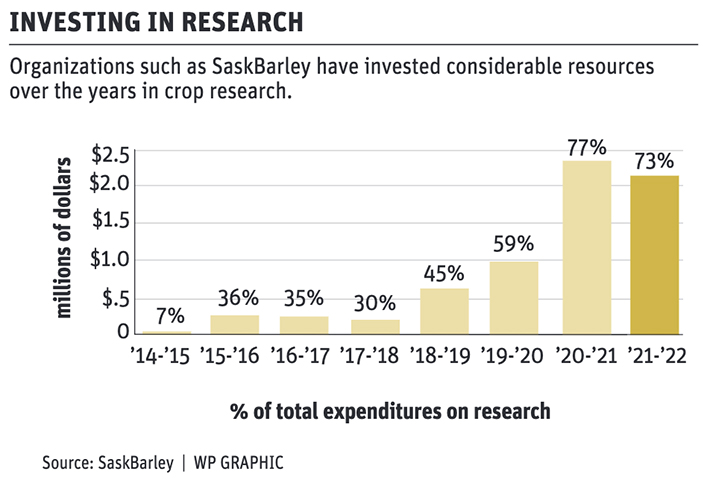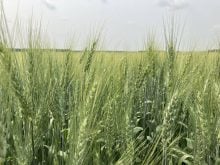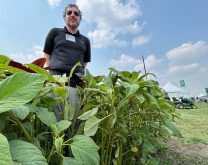Agriculture Canada grows a living museum that highlights the history of wheat development in Western Canada
LANGHAM, Sask. — Newspapers are chronicles of the history they cover in real time.
If one goes far back into The Western Producer’s archives, they will find frequent references to famous names like Red Fife, Marquis and Thatcher, which were the dominant wheat varieties of their times.
Those names are seldom heard nowadays, but Agriculture Canada wheat developers brought them back through the mists of time to stand proudly before farmers at the Ag in Motion outdoor farm show held near Saskatoon in July. In side-by-side plots beginning with Red Fife and ending with Starbuck, farmers could see a living museum of the history of wheat development in Western Canada.
“We still go back to them,” said Santosh Kumar, a wheat breeder with Ag Canada in Brandon, explaining how seeds for the ancient varieties are still available.
“They aren’t dinosaurs yet.”
But like dinosaurs, yesteryear’s wheat varieties are huge, lumbering beasts compared to the smaller, quicker, more efficient creatures that dominate today’s farm fields. Red Fife, the variety that made wheat farming possible in Western Canada’s short growing season and struggles with rust diseases, grows tall and green, truly the King Wheat of lore.
Today’s Starbuck isn’t nearly so impressive to the casual glance. It’s a dwarf compared to Red Fife. Rather than a rich green, it sports a blue tinge to its squat and modest frame. When Ag Canada crop physiologist Raju Soolanayakanahally stands beside the two, the Starbuck heads strive to reach his mid-thigh, while Red Fife tickles his beltline.
However, deeper inside the genetics, biology and understanding of wheat growing agronomy, Starbuck is an awesome evolutionary improvement on Red Fife, which was itself a radical improvement on the “Siberian” wheat that failed to thrive in Canadian conditions back in the 1840s.

Through successive waves of breeding, scientists have continually advanced wheat development, averaging a one percent gain in yields per year, taking the crop down a number of paths toward ever-better performance.
The green revolution of the 1960s and 1970s saw breeders hammer down the height and vegetative mass of the wheat plant, allowing much more energy to be pushed into kernel development. The awns on the heads, known as the beards, were bred out as another waste of energy.
That allowed yields to increase, but even as that occurred, the next surge in breeding advancement was coming, including one that was a reversal of one of the “gains.”
Early wheats like Red Fife and Marquis were very green, which showed their great photosynthetic abilities. But they also got very hot within the stand, and the plants would suck up much soil moisture to cool themselves.
Breeders responded by sculpting wheat architecture to better absorb sunlight, stay cool and produce bigger heads. Leaves were made smaller but wider, allowing sun to reach down to the bottom of plants and provide a better all-plant exposure. The flag leaf was bolstered by being made fatter and shorter, allowing more energy to be thrown into the head while not blocking sunlight from lower parts of the stem.
And breeders pulled in a waxy, blueish element to the leaves, allowing them to absorb sunlight while keeping cooler and preserving soil moisture.

“The wax acts as a sunscreen,” said Soolanayakanahally.
Beards were brought back to push back against the constant onslaught of insects, which have a tougher time getting a meal if they have to face the awns first.
“It provides a little mechanical resistance to the insect,” said Soolanayakanahally.
Wheat is far from perfected. Today’s wheat cultivars carry their own rich genetic structure, but historic wheat varieties offer a further smorgasbord of genes that breeding and history have almost left behind — except for deep-freeze stores of historic seeds kept by breeders and in seed banks.
“We have our own stash and we go back to the gene bank to get some of that,” said Kumar, who noted that several years of registration trials include genetic material brought into modern varieties through breeding from the 1980s.
Soolanayakanahally said he enjoyed hearing farmers’ memories of the historic varieties. Some recalled the introduction of new varieties by how they related to the birth of their children, or when they started farming.
“People relate to their own histories and where they stand with wheat on their farms,” he said.
















